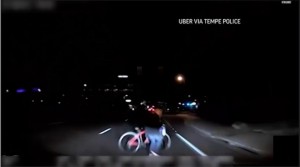
The Tempe (Arizona) Police Department released the video footage of Uber's collision with a pedestrian.
Uber disconnected the safety system already installed in the Volvo XC90 that would have prevented the fatal crash in Arizona March 18, to test its own system with catastrophic results, according to a supplier for Volvo’s system.
Aptiv Plc told Bloomberg News that it wants to make sure there is no confusion about what safety systems were in place during the collision earlier this month. Aptiv, which works with Mobileye, to produce Volvo’s collision mitigation system says it doesn’t want its equipment or reputation to be impacted by the incident.
“We don’t want people to be confused or think it was a failure of the technology that we supply for Volvo, because that’s not the case,” Zach Peterson, a spokesman for Aptiv told Bloomberg. The Volvo XC90’s standard advanced driver-assistance system “has nothing to do” with the Uber test vehicle’s autonomous driving system, he said.
Uber’s system, which now has been revealed to be riddled with problems, did not slow down or swerve to avoid Elaine Herzberg, 49, as she crossed the street pushing a bicycle. Video footage also shows that the back-up or safety driver was looking down in the seconds before the collision.
Police in Tempe, Arizona, and the National Transportation Safety Board are investigating the incident, although Tempe Police officials were quick to suggest that the accident could not be avoided, additional research is casting down on that assertion.
Though Uber has suspended all of its testing as part of its protocols, Arizona Gov. Doug Ducey suspended the company’s permit to do on-road testing indefinitely. Ducey did not offer a timetable for when the suspension may be lifted.
Uber and Volvo declined to comment. Intel Corp., which produces the chips and sensors for the existing system said it ran tests using the same scenario that its equipment was able to detect Herzberg crossing the street.
In fact, the company noted its systems were able to avoid a collision repeatedly despite the “poor second hand” video released by the Tempe Police Department. Several industry experts support the assertion that the vehicle had plenty of time – and should have – avoided Herzberg.
The company’s never revealed specifically how its autonomous system works, but it uses a system of cameras, radar and lidar to “see” things. While the camera would be largely ineffective at night, the radar and lidar should have been able to detect something that large.
“It seems it should have detected her,” Daniel Sperling, director of the Institute for Transportation Studies at University of California Davis told Reuters in an email after viewing the video. “It seems unlikely that a human driver would have done better. We do want AVs to do better than us and the potential exists.”
To help circumvent a problem, Uber hires humans to sit in the driver’s seat to act as backups in the event the autonomous system fails. There was a human on board during this test run. However, the video footage shows her looking down just before the accident, and though it’s not certain that she could have done anything to prevent the collision, the fact that she was not focused on the road makes impossible to know.
The accident leaves automakers and tech companies that have been testing vehicles in the real world grappling with what to do

I hope the OEMs are paying attention:
“It wasn’t my ________ (fill in the blank, microprocessor, sensor, software, harness, connector, transistor, amplifier, DV test, SW validation, …), you didn’t use it properly.”
We’re likely to see autonomous vehicle conditions of use on electronic data sheets, similar to this on a TI amplifier:
No TI components are authorized for use in FDA Class III (or similar life-critical medical equipment) unless authorized officers of the parties have executed a special agreement specifically governing such use.